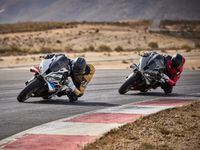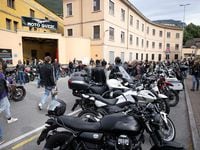Moto2 has become a successful international racing class because it fulfills its intended purpose: the schooling of a steady supply of skilled, experienced riders to move up into MotoGP. Moto2 is based on a mildly tuned one-design spec engine, all of which are guaranteed to give the same power for all riders, within 3 percent. The engines are mounted in anything-goes GP chassis. Teams are free to build their own chassis or buy from builders such as Kalex, Speed Up, and Suter. Spec fuel and tires complete the concept.
Moto2 originally drew criticism because it was a big change from the class it replaced, 250cc GP, which was traditional in that engine development was up to the individual teams or factories involved. Removing the engine from the list of variables seemed wrong.
On the other hand, engine development has become too sophisticated for private teams to afford, giving great advantage to factory or factory-assisted teams. The price of a two-stroke 250cc production racer rose from $1,850 in 1972 to $7,000 in 1982, and then soared to $25,000 by 1995. The yearly cost of a seat on a 250cc GP team (two bikes, spares, and tech assistance) then rose to roughly $1 million by 2010.
History shows the racing series that have produced the most top riders have been intensely competitive—riders learn from each other. Such series have always had nearly identical engines: British short-circuit racing of the 1950s and ’60s, using 350cc and 500cc singles; AMA racing of the 1970s with all riders on Yamaha TZ750s; and the various near-stock Supersport classes of several nations. All have produced numerous strong riders.
When the original GP classes 125cc, 250cc, 350cc, 500cc and sidecar were created in 1949, motorcycling was very different. At that time, many manufacturers in Italy and Spain produced only lightweights, and there were professional riders who remained in those classes, which were not a ladder to be climbed. The classes created by Dorna in this century—Moto3, Moto2, and MotoGP—are very much intended as a ladder to MotoGP. Why? Because the old structure of national and regional international races, which in former times supplied experienced and skilled riders, is now either weakened or gone.
Originally, Moto2 was expected to unleash a flood of chassis creativity, alternatives to the existing orthodoxy of telescopic fork, twin aluminum-beam chassis, and swingarm rear suspension. Radical chassis experiments take time and require costly prototyping and testing, but to find financial support, race teams must become competitive now. To have the best chance of doing so, they use whichever chassis is currently most often on the podium. A typical Moto2 chassis is said to cost around 100,000 euros.
For 2019, under a three-year contract, the Moto2 engine will change from the Honda CBR600RR inline-four that has powered the class since 2010 to a 765cc Triumph triple. Dorna hopes this 28 percent increase in engine displacement will provide better training for the transition to MotoGP's 1,000cc monsters. Triumph expects to benefit from exposure of its brand name to the emerging markets of Asia, where MotoGP is increasingly popular.
The mechanics of Moto2’s engine supply are handled by a seven-man Spanish operation named ExternPro and based at the MotorLand Aragón race circuit. After three races, engines are given new pistons, crankshaft, and connecting rods, and after assembly are run in on the dyno for two hours so that no end user break-in is required. Among one recent batch of such rebuilds, the total horsepower variation was 1.2 hp.
The Honda engines in the program have been stock with the following exceptions, and modification parts have come from the HRC World Supersport engine kit:
- Ported cylinder head (mainly to remove normal production differences)
- Race camshaft lift and timings
- Titanium valves and stiffer valve springs
- Magneti Marelli ECU
- Tunable slipper clutch
- Taller first gear (stock first gear is too low for racetrack use)
- Reduced width (angled crankcase covers for greater cornering clearance)
- Lower-output kit alternator (no lighting is fitted)
- Modified deep oil sump for improved exhaust-pipe clearance
The result of this program has been 125–128 hp with a redline of 15,900 rpm.
With so many normal variables controlled in this way, it is up to the riders to find ways to win. Marc Márquez is the best example of how this works, for Márquez brought to MotoGP the techniques of tire conservation that two years in Moto2 forced him to develop. What a surprise it was for established MotoGP stars to find that the newcomer was very often better able than they to make his tires last the race distance. By contrast, riders who “go for it” in Moto2 may lead the early laps but fall back as their abused tires lose grip. Moto2 has become the university of tire management.
Related: Fundamentals Of Unsprung Weight
The Triumph 765 triple about to take over Moto2 race duties as spec engine next year has the modern sportbike/racing bore and stroke of 77.99 x 53.38mm, for a bore/stroke ratio of 1.46 (the limit in MotoGP is 1.67, or 81 x 48.5mm). If we assume the 765 gives stroke-averaged net-combustion pressure equal to the Honda spec engine, at 13,000 rpm the result would be just over 140 hp.
Former 125cc GP World Champion Julián Simón has ridden 765 prototypes at three tracks in Spain, saying, “In particular, the midrange is very impressive.” That is one of the benefits of following the age-old rule that a better engine results from enlarging a smaller design than from sleeving down a bigger one. The smaller intake ports of the original engine give the enlarged version stronger midrange torque.
The 765 is an enlargement of the older 675 and, like many engines of an earlier time, has its engine mounts high on its cylinder head. The flexible chassis revolution begun by Honda early in MotoGP is based upon the greater flexibility of longer engine bearers extending down to crankcase level. It will therefore be interesting to see how the chassis builders achieve the necessary flexibility despite the Triumph’s higher forward engine mounts.
In other respects, the Triumph is a thoroughly modern DOHC design, sharing the basic architecture of the latest inline-fours with a vertically stacked gearbox, high clutch, flat, narrow-valve-angle combustion chambers, and main-bearing oiling from a transverse oil gallery directly under the crankshaft. Tucked between the crank and oil sump are the chain-drive water and oil pumps.
There is a further special treat to which we can look forward in 2019: There is no engine sound more musical than that of a triple.











/cloudfront-us-east-1.images.arcpublishing.com/octane/HZTCSNLGDZDEDJA3YCF4SWMFGI.jpg)
/cloudfront-us-east-1.images.arcpublishing.com/octane/ISPPFR2XVNHE3B3PKIWZEYHBEE.jpg)
/cloudfront-us-east-1.images.arcpublishing.com/octane/MQXQRYMZVBCWJIRYP3HEN3SHVE.jpg)
/cloudfront-us-east-1.images.arcpublishing.com/octane/TSPODNNEWRDSVJGUCNQTDG4ADI.jpg)
/cloudfront-us-east-1.images.arcpublishing.com/octane/X5TB7BDV4BA2RPSY54ZGK27RP4.jpg)
/cloudfront-us-east-1.images.arcpublishing.com/octane/REUHOJXRDBGZ5IHBYZCCBCISPA.jpg)
/cloudfront-us-east-1.images.arcpublishing.com/octane/52LGJTCKBFEHDF7S7H4CVUIMGM.jpg)
/cloudfront-us-east-1.images.arcpublishing.com/octane/YMWAIPIPSJAOXOU3QMJMGH37OM.jpg)


/cloudfront-us-east-1.images.arcpublishing.com/octane/EJ6KZRGAYBCVXNL2PJXL37UVWQ.jpg)
/cloudfront-us-east-1.images.arcpublishing.com/octane/AAN4TI76M5H5JMUVEIGASWXBDU.jpg)
/cloudfront-us-east-1.images.arcpublishing.com/octane/P3RXD2UCPFF37CMB7CHPVKXORY.jpg)
/cloudfront-us-east-1.images.arcpublishing.com/octane/VZEG2EJI2RDFZNHLRZMU56MD3Q.jpg)
/cloudfront-us-east-1.images.arcpublishing.com/octane/GVJQO5FFOFBWNGODOBRB4FBAW4.jpg)
/cloudfront-us-east-1.images.arcpublishing.com/octane/BIVAK2SFIBDJJM25E7I5VU2FJE.jpg)
/cloudfront-us-east-1.images.arcpublishing.com/octane/CH5VX52UG5CFHOVH5A6UYEFWWA.jpg)
/cloudfront-us-east-1.images.arcpublishing.com/octane/ZVGJNGZRU5C33N7KN23BBFKSC4.jpg)


/cloudfront-us-east-1.images.arcpublishing.com/octane/CZ5OM3E43ZEXJHY7LCYXCHLIKI.jpg)
/cloudfront-us-east-1.images.arcpublishing.com/octane/DF5T4K5KPZFJXFCTGPYR77PKJM.jpg)
/cloudfront-us-east-1.images.arcpublishing.com/octane/RMCT2KVQBJHBZMRTSLOVPMOILU.jpg)

/cloudfront-us-east-1.images.arcpublishing.com/octane/K45KB2XHQVA65DX7VN4ZSMT2BI.jpg)
/cloudfront-us-east-1.images.arcpublishing.com/octane/FNHXQQ56BRD7TO4YIJ453PNG2M.jpg)